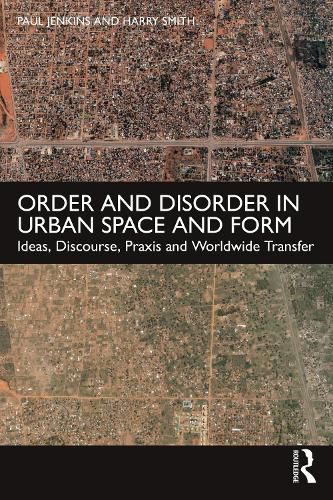Readings Newsletter
Become a Readings Member to make your shopping experience even easier.
Sign in or sign up for free!
You’re not far away from qualifying for FREE standard shipping within Australia
You’ve qualified for FREE standard shipping within Australia
The cart is loading…






What constitutes spatial order in a city? What urban forms do we consider as disorderly?
The worldwide assertion over the years of Enlightenment-derived concepts of social order through urban form suggests that we also believe we know how to create an (future) ordered environment. But these notions of order and disorder desperately need interrogation.
There has been a great revival of Enlightenment-derived urban forms in the global North in recent years - the gridiron, hierarchies of architectural form, the traditional street and square. But not only is it clear that such forms have failed to failed to produce more social order, as was intended, but it has become more abundantly is equally clear that the imposition of the same ideas in cities of the South cuts across alternative systems of social and cultural order. If we are serious about ordering the urban realm - as almost all architects, urban designers and planners are - then it is time to rethink what we mean by order in the first place. As this provocative and timely book shows, what we think of as urban order is partial and restricted - and what we perceive as disorder usually masks underlying orders of another kind.
This book critically analyses the development of the concept of spatial order in modern urban form in from the period of the European Enlightenment, the export of the Enlightenment outside of Europe, the supersession of the Enlightenment in the cities of the global South, and the now likely export of post-Enlightenment concepts of order back to Europe. The authors argue that social order and cultural values have more fundamental importance than ordered urban form in creating urban places in cities, and that urban designers, planners, architects and other built environment professionals need to base their approach to the moulding of urban space through new urban forms on deeper inter-disciplinary understanding of underlying social order.
A different approach to emerging urban space and form therefore needs to start from an understanding of the cultural imaginaries and social constructs that underpin the production of most city fabric and engage with these concepts and organisational forms to improve urban life for the majority.
$9.00 standard shipping within Australia
FREE standard shipping within Australia for orders over $100.00
Express & International shipping calculated at checkout
What constitutes spatial order in a city? What urban forms do we consider as disorderly?
The worldwide assertion over the years of Enlightenment-derived concepts of social order through urban form suggests that we also believe we know how to create an (future) ordered environment. But these notions of order and disorder desperately need interrogation.
There has been a great revival of Enlightenment-derived urban forms in the global North in recent years - the gridiron, hierarchies of architectural form, the traditional street and square. But not only is it clear that such forms have failed to failed to produce more social order, as was intended, but it has become more abundantly is equally clear that the imposition of the same ideas in cities of the South cuts across alternative systems of social and cultural order. If we are serious about ordering the urban realm - as almost all architects, urban designers and planners are - then it is time to rethink what we mean by order in the first place. As this provocative and timely book shows, what we think of as urban order is partial and restricted - and what we perceive as disorder usually masks underlying orders of another kind.
This book critically analyses the development of the concept of spatial order in modern urban form in from the period of the European Enlightenment, the export of the Enlightenment outside of Europe, the supersession of the Enlightenment in the cities of the global South, and the now likely export of post-Enlightenment concepts of order back to Europe. The authors argue that social order and cultural values have more fundamental importance than ordered urban form in creating urban places in cities, and that urban designers, planners, architects and other built environment professionals need to base their approach to the moulding of urban space through new urban forms on deeper inter-disciplinary understanding of underlying social order.
A different approach to emerging urban space and form therefore needs to start from an understanding of the cultural imaginaries and social constructs that underpin the production of most city fabric and engage with these concepts and organisational forms to improve urban life for the majority.